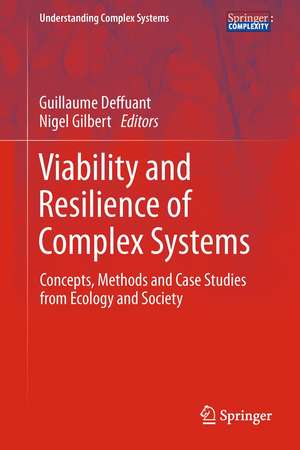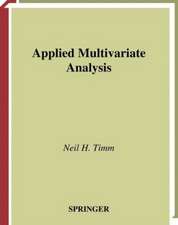Viability and Resilience of Complex Systems: Concepts, Methods and Case Studies from Ecology and Society: Understanding Complex Systems
Editat de Guillaume Deffuant, Nigel Gilberten Limba Engleză Paperback – 27 noi 2013
This book demonstrates how new methods can be used to identify the actions favouring the recovery from perturbations. Examples discussed include bacterial biofilms resisting detachment, grassland savannahs recovering from fire, the dynamics of language competition and Internet social networking sites overcoming vandalism.
The reader is taken through an introduction to the idea of resilience and viability and shown the mathematical basis of the techniques used to analyse systems. The idea of individual or agent-based modelling of complex systems is introduced and related to analytically tractable approximations of such models. A set of case studies illustrates the use of the techniques in real applications, and the final section describes how one can use new and elaborate software tools for carrying out the necessary calculations.
The book is intended for a general scientific audience of readers from the natural and social sciences, yet requires some mathematics to gain a full understanding of the more theoretical chapters.
It is an essential point of reference for those interested in the practical application of the concepts of resilience and viability
| Toate formatele și edițiile | Preț | Express |
|---|---|---|
| Paperback (1) | 637.46 lei 6-8 săpt. | |
| Springer Berlin, Heidelberg – 27 noi 2013 | 637.46 lei 6-8 săpt. | |
| Hardback (1) | 643.65 lei 6-8 săpt. | |
| Springer Berlin, Heidelberg – 3 aug 2011 | 643.65 lei 6-8 săpt. |
Din seria Understanding Complex Systems
- 18%
 Preț: 1112.30 lei
Preț: 1112.30 lei -
 Preț: 439.25 lei
Preț: 439.25 lei - 18%
 Preț: 1119.38 lei
Preț: 1119.38 lei - 15%
 Preț: 401.82 lei
Preț: 401.82 lei - 18%
 Preț: 1247.26 lei
Preț: 1247.26 lei - 15%
 Preț: 641.20 lei
Preț: 641.20 lei - 15%
 Preț: 642.68 lei
Preț: 642.68 lei - 15%
 Preț: 651.51 lei
Preț: 651.51 lei - 18%
 Preț: 946.55 lei
Preț: 946.55 lei - 18%
 Preț: 947.98 lei
Preț: 947.98 lei - 20%
 Preț: 650.27 lei
Preț: 650.27 lei - 18%
 Preț: 952.09 lei
Preț: 952.09 lei - 18%
 Preț: 957.13 lei
Preț: 957.13 lei - 18%
 Preț: 943.88 lei
Preț: 943.88 lei -
 Preț: 398.35 lei
Preț: 398.35 lei - 5%
 Preț: 1417.54 lei
Preț: 1417.54 lei - 15%
 Preț: 648.42 lei
Preț: 648.42 lei -
 Preț: 387.75 lei
Preț: 387.75 lei - 18%
 Preț: 1133.76 lei
Preț: 1133.76 lei - 18%
 Preț: 948.16 lei
Preț: 948.16 lei - 20%
 Preț: 655.85 lei
Preț: 655.85 lei - 18%
 Preț: 1113.09 lei
Preț: 1113.09 lei - 20%
 Preț: 655.53 lei
Preț: 655.53 lei - 15%
 Preț: 653.00 lei
Preț: 653.00 lei - 18%
 Preț: 1332.92 lei
Preț: 1332.92 lei - 18%
 Preț: 1010.48 lei
Preț: 1010.48 lei - 18%
 Preț: 955.56 lei
Preț: 955.56 lei -
 Preț: 384.22 lei
Preț: 384.22 lei - 18%
 Preț: 950.66 lei
Preț: 950.66 lei - 15%
 Preț: 638.43 lei
Preț: 638.43 lei - 15%
 Preț: 644.49 lei
Preț: 644.49 lei - 15%
 Preț: 647.40 lei
Preț: 647.40 lei - 15%
 Preț: 649.06 lei
Preț: 649.06 lei - 15%
 Preț: 639.25 lei
Preț: 639.25 lei - 15%
 Preț: 643.65 lei
Preț: 643.65 lei - 18%
 Preț: 960.78 lei
Preț: 960.78 lei - 15%
 Preț: 649.87 lei
Preț: 649.87 lei - 15%
 Preț: 645.47 lei
Preț: 645.47 lei
Preț: 637.46 lei
Preț vechi: 749.95 lei
-15% Nou
Puncte Express: 956
Preț estimativ în valută:
121.99€ • 126.89$ • 100.71£
121.99€ • 126.89$ • 100.71£
Carte tipărită la comandă
Livrare economică 14-28 aprilie
Preluare comenzi: 021 569.72.76
Specificații
ISBN-13: 9783642270345
ISBN-10: 3642270344
Pagini: 236
Ilustrații: XII, 224 p.
Dimensiuni: 155 x 235 x 12 mm
Greutate: 0.34 kg
Ediția:2011
Editura: Springer Berlin, Heidelberg
Colecția Springer
Seria Understanding Complex Systems
Locul publicării:Berlin, Heidelberg, Germany
ISBN-10: 3642270344
Pagini: 236
Ilustrații: XII, 224 p.
Dimensiuni: 155 x 235 x 12 mm
Greutate: 0.34 kg
Ediția:2011
Editura: Springer Berlin, Heidelberg
Colecția Springer
Seria Understanding Complex Systems
Locul publicării:Berlin, Heidelberg, Germany
Public țintă
ResearchCuprins
Preface.- Part I Concepts.- What is Resilience? A Short Introduction.- Defining Resilience Mathematically: From Attractors to Viability.- Part II Case Studies.- Viability and Resilience in the Dynamics of Language Competition.- Viable Web Communities:Two Case Studies.- Computational Savanna Models and Viability Based Resilience.- Viability and Resilience of a Bacterial Biofilm Individual-Based Model.- Part III Tools and Techniques.- Approximating Viability Kernels and Resilience Values with KAVIAR.- Geometric Robustness of Viability Kernels and Resilience Basins.
Recenzii
From the reviews:
“In this book, a consortium of researchers … suggested measures to formalize the concept of resilience by following viability theory, which can also be extremely useful to design management policies in different environments. … To sum up, this book is highly recommended to scientists from a wide range of disciplines dealing with complex agent-based systems, where some of the main issues are the calculation of stability of the non-equilibrium states and the robustness under some disturbances.” (Albert Diaz-Guilera, Journal of Artificial Societies and Social Simulation, April, 2012)
“In this book, a consortium of researchers … suggested measures to formalize the concept of resilience by following viability theory, which can also be extremely useful to design management policies in different environments. … To sum up, this book is highly recommended to scientists from a wide range of disciplines dealing with complex agent-based systems, where some of the main issues are the calculation of stability of the non-equilibrium states and the robustness under some disturbances.” (Albert Diaz-Guilera, Journal of Artificial Societies and Social Simulation, April, 2012)
Textul de pe ultima copertă
One common characteristic of a complex system is its ability to withstand major disturbances and the capacity to rebuild itself. Understanding how such systems demonstrate resilience by absorbing or recovering from major external perturbations requires both quantitative foundations and a multidisciplinary view of the topic.
This book demonstrates how new methods can be used to identify the actions favouring the recovery from perturbations on a variety of examples including the dynamics of bacterial biofilms, grassland savannahs, language competition and Internet social networking sites.
The reader is taken through an introduction to the idea of resilience and viability and shown the mathematical basis of the techniques used to analyse systems. The idea of individual or agent-based modelling of complex systems is introduced and related to analytically tractable approximations of such models. A set of case studies illustrates the use of the techniques in real applications, and the final section describes how one can use new software tools for carrying out the necessary calculations.
The book is intended for a general scientific audience of readers from the natural and social sciences, although it requires some mathematics to gain a full understanding of the more theoretical chapters.
It is an essential point of reference for those interested in the practical application of the concepts of resilience and viability
This book demonstrates how new methods can be used to identify the actions favouring the recovery from perturbations on a variety of examples including the dynamics of bacterial biofilms, grassland savannahs, language competition and Internet social networking sites.
The reader is taken through an introduction to the idea of resilience and viability and shown the mathematical basis of the techniques used to analyse systems. The idea of individual or agent-based modelling of complex systems is introduced and related to analytically tractable approximations of such models. A set of case studies illustrates the use of the techniques in real applications, and the final section describes how one can use new software tools for carrying out the necessary calculations.
The book is intended for a general scientific audience of readers from the natural and social sciences, although it requires some mathematics to gain a full understanding of the more theoretical chapters.
It is an essential point of reference for those interested in the practical application of the concepts of resilience and viability
Caracteristici
Authored and edited by leading researchers in the field Suitable as self-study guide at graduate level Provides both theory and many concrete applications
















